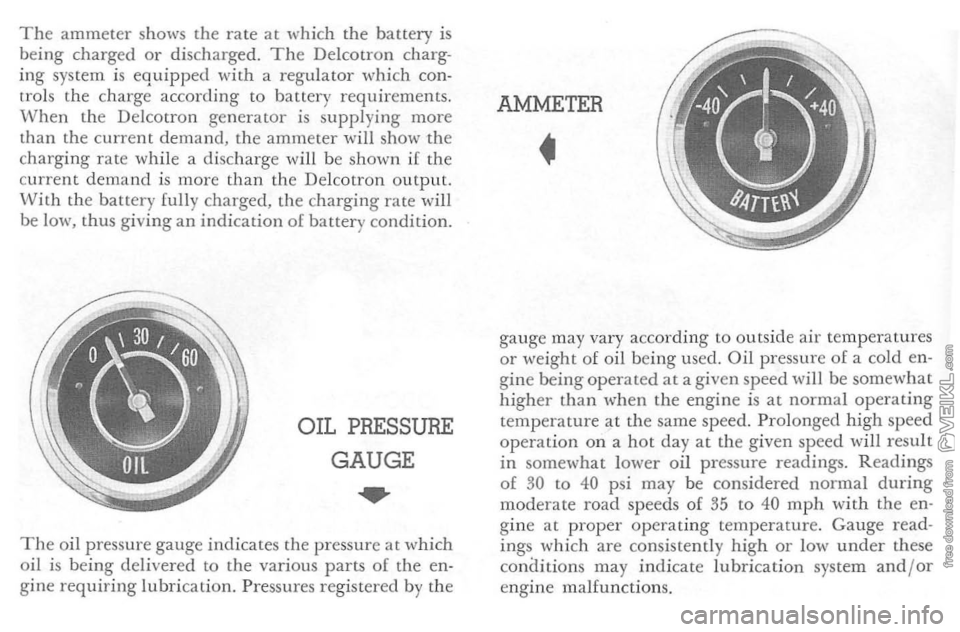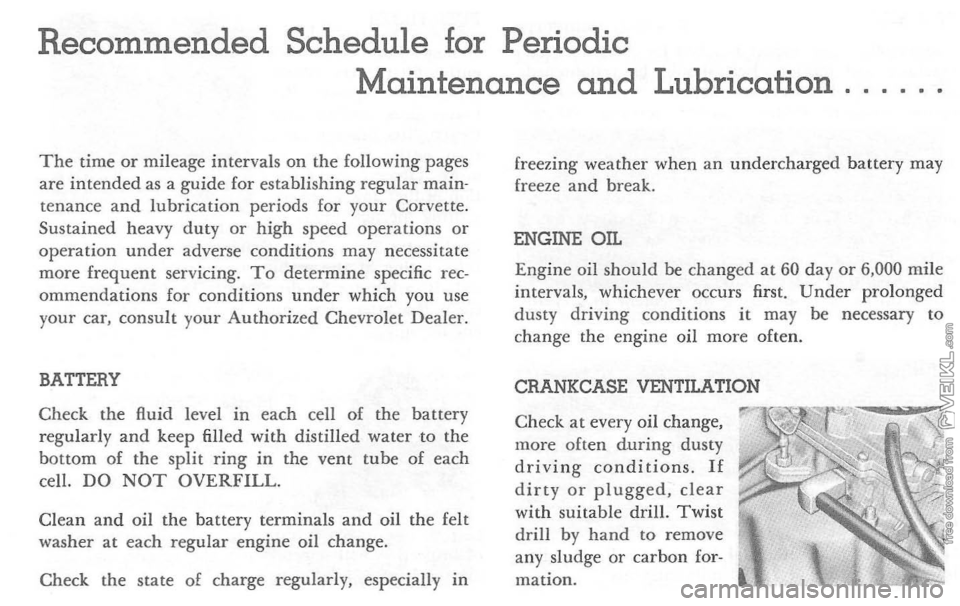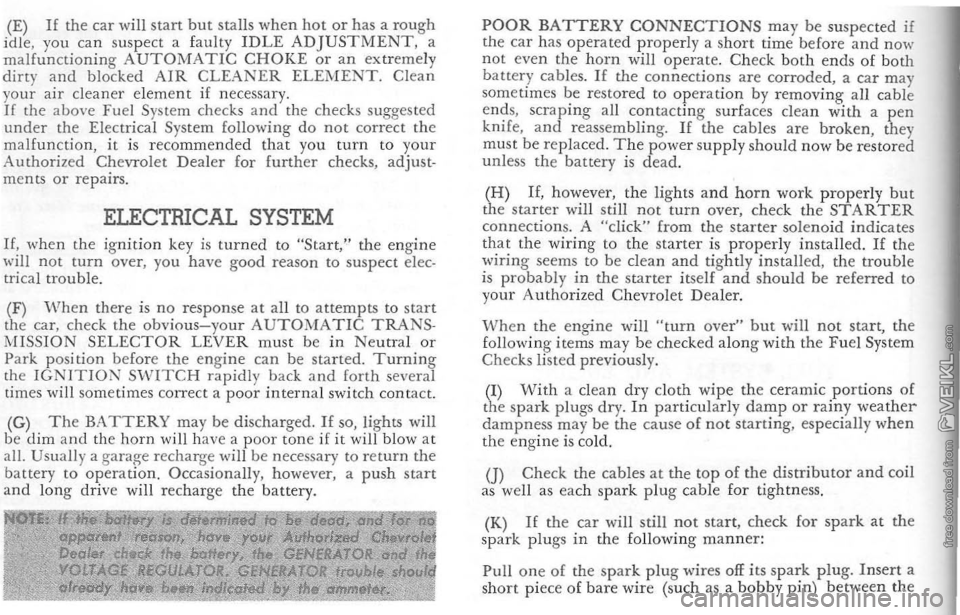battery CHEVROLET CORVETTE 1964 Owners Manual
[x] Cancel search | Manufacturer: CHEVROLET, Model Year: 1964, Model line: CORVETTE, Model: CHEVROLET CORVETTE 1964Pages: 52, PDF Size: 11.2 MB
Page 15 of 52

The ammeter shows the rate at which the battery is being charged or discharged. The Delcotron charg
ing system is equipped 'with a regulator which con
trol s the charge acco rding to battery requirements.
When the Delcotron generator is supp lying more
than the curre nt demand, the ammeter will show the
chargi ng rate while a disc harg e will be shown if
the
current demand is more than the Delcotron output.
With the battery fully charged , the charging rate will be 1m-\', thus giving an indication of battery condition.
OIL PRESSURE
GAUGE
...
The oil pressure gauge indicates the pressure at which
oil is being delivered to the various parts of the en·
gine requiring lubrication. Pressures registered by the
AMMETER
•
gauge
may vary acco rding to outside air temperatures or weight of oil being used. Oil pressure of a cold en
gine being operated at a given speed will be somewhat
higher than when the engine is at normal operating
temperature at the sam e speed. Prolonged high speed operation on a hot day at the giv en speed will result in somewhat lower oil pressure readings. Readings of 30 to 40 psi may be considered normal during moderate road speeds of 35 to 40 mph with the en
gine at proper operating temperature. Gauge read
in gs whi ch are consistently high or low under these
co nCIitions may ind i cate lubrication system and/or
engine malfunctions.
Page 36 of 52

Recommended Schedule for Periodic
Maintenance
and Lubrication
The time or mileage intervals on the following pages
are intended as a guide for establishing regular main
tenance and lubrication periods for your Corvette .
Sustained heavy
duty or high speed operations or operation under adverse conditions may necessitate
more frequent servicing. To determine specific recommendations for conditions under which you use
your car, consult your Authorized Chevrolet Dealer.
BATTERY
Check the fluid level in each cell of the battery regularly and keep filled with distilled water to the bottom of the split ring in the vent tube of each
cell. DO NOT OVERFILL.
Clean and oil the battery terminals and oil the felt
washer at each regular engine oil change.
Check the state
of charge regularly, especially in
freezing weather when an undercharged battery may
freeze and break.
ENGINE OIL
Engine oil should be changed at 60
day or 6,000 mile intervals. whichever occurs first. U ndef prolonged
dusty driving conditions it may be necessary to
change the engine oil more often.
CRANKCASE VENTILATION
Check
at every oil change,
more often during dusty driving conditions. If dirty or plugged, clear with suitable drill. Twist drill by hand to remove
any sludge or carbon for
mation.
Page 43 of 52

(E) If the car will start but sta lls w h e n hot or has a roug h idle, you can sus pect a f aulty IDLE ADJUSTMENT, a malfunctioning AUTOMATIC CHOKE or an extremely
dirty and blocked AIR CLEANER ELEMENT. Clean
your air cleaner element if necessary. If the above Fuel Syste m checks and the checks suggested under the Electr ica l System followi ng do not corre ct the malfunction , i t is recommended that you turTI to your Authorized Chevrolet Dealer for further checks, adjust
ments or repairs.
ELECTRICAL SYSTEM If, when the ignition key is turned to "Star t," the engine
will not turn over, you have good reason to sus pec t elec
trical trouble.
(F) '
Vhen there is
no response at all to attempts to star t
the car , check the obv ious-your AUTOMATIC TRANS· M ISSION SELECTOR LEVER mus t be in Neutral or Park position befor e the engine can be started. Turning
the IGNITION SvVITCH rapidly back and forth several
times will sometimes correct a poor internal switch contact.
(G) The BATTER Y may be discha rged. If so, lights will
be dim and the horn will have a poor tone if it will blow a t
all. Usually a
garage recharge will be nece ssary to return the battery to operation. Occasiona lly, however, a p u sh start and long driv e will recharge the battery .
POOR BATTERY CONNECTIONS may be suspec ted if
th e car has operated prope rly a short time befor e and now not eve n the horn will operate. Check both ends o f both battery cables. If the connections are corroded, a car ma y
som etimes be restore d to operation by removing all cab le
e n ds, scraping all contacting surfaces clean with a pen
knife, and reassembling. If the cables a r e broken, they
must be replaced. The power supply should now b e restored
unless the battery is dead.
(H)
If, however, the lights and horn work properly but
th e starter will still not turn ove r , c heck the STARTER connections. A "click " from the starter soleno id indicates
th a t the wirin g to the starter is properly install ed. If the
wiring seems to be clean and tightly installed, the trouble
is proba bly in the starter itself and sho uld be referred to
your Authorized Chevr olet Dealer.
When the e ngine will "turn ove r " but will not start, [h e
foll owin g items may b e checked along with the Fuel Syst em
Checks listed previous ly.
(I) With a clean dry cloth wipe the ceramic portions o f
t he spark plugs dry. In particul arly damp or rainy weather dampness may be the cause of not starting, espec ially when the e ngin e is cold.
0) C heck the cables
at the top of the distributor and coil as well as eac h spark plug cable for tightness.
(K)
If the car w ill stilI not st art. ch eck for spark at the
spark plugs in th e foll owing manner:
Pull o n e of the spark plug wi res off its spark plug. Insert a
short piece of bare wir e (such as a bobby pin) between the